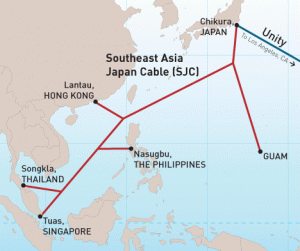 As the world evolves technologically and becomes more sophisticated and even more connected – global telecom carriers continue to commit millions of dollars in vital infrastructure to keep communication flowing via the necessary bandwidth capacity for intercontinental communications.
As the world evolves technologically and becomes more sophisticated and even more connected – global telecom carriers continue to commit millions of dollars in vital infrastructure to keep communication flowing via the necessary bandwidth capacity for intercontinental communications.
Trans-Pacific bandwidth demand has grown constantly at a compounded annual growth rate (CAGR) of 64% between fiscal ’02 and ’07. Based on telegeography global bandwidth reports, the growth will continue to persist strongly from 2008 to 2013, with total demand for capacity doubling roughly every 24 months.
As global demand for connectivity and bandwidth continues to increase, particularly in the Asia Pacific region ; a group of six international companies, including Google (GOOG), dubbed the Southeast Asian Japan Cable [SJC] – according to telegeography, would link Unity’s $300M Trans-Pacific infrastructure landing station in Japan to Guam, Hong Kong, the Philippines, Thailand and Singapore.
The SJC consortium is a joint effort by Bharti Airtel, Global Transit, Google, KDDI Corporation and SingTel. Pacnet, notes tg – which will control two fibre pairs on Unity (the new 10,000 kilometer Trans-Pacific cable system aimed at providing connectivity between Chikura, located off the coast near Tokyo, to Los Angeles and other West Coast network points of presence) already operates the EAC-C2C intra-Asian mesh cable system and consequently is not involved with SJC.
Given the current flurry of undersea cables under construction, the SJC cable will probably not be ready for service until 2011 at the earliest – said TeleGeography analyst Alan Mauldin.
The system is still in the planning stage, and a supply contract is yet to be announced.
- Bulenox: Get 45% to 91% OFF ... Use Discount Code: UNO
- Risk Our Money Not Yours | Get 50% to 90% OFF ... Use Discount Code: MMBVBKSM
Disclaimer: This page contains affiliate links. If you choose to make a purchase after clicking a link, we may receive a commission at no additional cost to you. Thank you for your support!


Leave a Reply